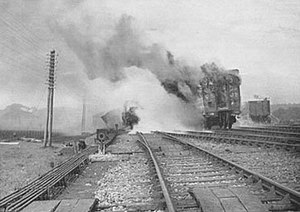Quintinshill rail disaster

Burning carriage in the aftermath of the collisions
|
|
| Date | 22 May 1915 |
|---|---|
| Time | 06:50 |
| Location | Quintinshill, Dumfriesshire |
| Coordinates | 55°00′53″N 3°03′54″W / 55.0146°N 3.0649°WCoordinates: 55°00′53″N 3°03′54″W / 55.0146°N 3.0649°W |
| Country | Scotland |
| Rail line | Caledonian Main Line part of the West Coast Main Line |
| Operator | Caledonian Railway |
| Type of incident | Double collision, fire |
| Cause | Signalling error |
| Statistics | |
| Trains | 5 |
| Deaths | 226 |
| Injuries | 246 |
| List of UK rail accidents by year | |
The Quintinshill rail disaster was a multi-train rail crash which occurred on 22 May 1915 outside the Quintinshill signal box near Gretna Green in Dumfriesshire, Scotland. It resulted in the deaths of over 200 people, and is the worst rail disaster in British history.
Quintinshill box controlled two passing loops, one on each side of the double-track Caledonian Main Line linking Glasgow and Carlisle (now part of the West Coast Main Line). At the time of the accident, both passing loops were occupied with goods trains and a northbound local passenger train was standing on the southbound main line.
The first collision occurred when a southbound troop train travelling from Larbert to Liverpool collided with the stationary local train. A minute later the wreckage was struck by a northbound sleeping car express train travelling from London Euston to Glasgow Central. Gas from the Pintsch gas lighting system of the old wooden carriages of the troop train ignited, starting a fire which soon engulfed all five trains.
Only half the soldiers on the troop train survived. Those killed were mainly Territorial soldiers from the 1/7th (Leith) Battalion, the Royal Scots heading for Gallipoli. The precise death toll was never established with confidence as some bodies were never recovered, having been wholly consumed by the fire, while the roll list of the regiment was also destroyed in the fire. The official death toll was 227 (215 soldiers, 9 passengers and three railway employees), but the army later reduced their 215 by one. Not counted in the 227 were four victims thought to be children, but which were never claimed or identified. The soldiers were buried together in a mass grave in Edinburgh's Rosebank Cemetery, where an annual remembrance is held.
...
Wikipedia
